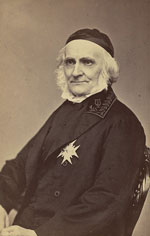Volume 28, Number 3—March 2022
Etymologia
Schizophyllum commune
Schizophyllum commune [skiz-of′-ǐ-ləm kom′-yoon]
Schizophyllum commune or split-gill mushroom, is an environmental, wood-rotting basidiomycetous fungus (Figure 1). Schizophyllum is derived from “Schíza” meaning split because of the appearance of radial, centrally split, gill like folds; “commune” means common or shared ownership or ubiquitous. Swedish mycologist, Elias Magnus Fries (1794–1878), the Linnaeus of Mycology, assigned the scientific name in 1815 (Figure 2). German mycologist Hans Kniep in 1930 discovered its sexual reproduction by consorting and recombining genomes with any one of numerous compatible mates (currently >2,800).
Isolation by Kligman in 1950 of fleshy fungus that had fan-shaped sporophores from a case of onychomycosis was regarded as interesting. However, it was dismissed as improbable because mushrooms were not known to invade animal tissue. This emerging fungal pathogen is characterized by the presence of clamp connections, hyphal spicules, and formation of basidiocarps with basidiospores.
References
- Chowdhary A, Kathuria S, Agarwal K, Meis JF. Recognizing filamentous basidiomycetes as agents of human disease: A review. Med Mycol. 2014;52:782–97. DOIPubMedGoogle Scholar
- Greer DL. Basidiomycetes as agents of human infections: a review. Mycopathologia. 1978;65:133–9. DOIPubMedGoogle Scholar
- O’Reilly P. Schizophyllum commune, split gill fungus, 2016 [cited 2021 Aug 23]. https://www.first-nature.com/fungi/schizophyllum-commune.php
Figures
Cite This ArticleOriginal Publication Date: February 02, 2022
Related Links
Table of Contents – Volume 28, Number 3—March 2022
| EID Search Options |
|---|
|
|
|
|
|
|


Please use the form below to submit correspondence to the authors or contact them at the following address:
Monika Mahajan, Medical Microbiology, Postgraduate Institute of Medical Education and Research, Research Block A, Sector 12, Chandigarh 160012, India
Top